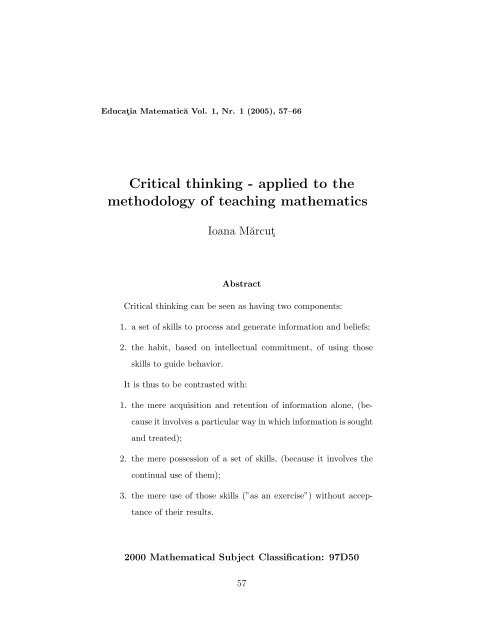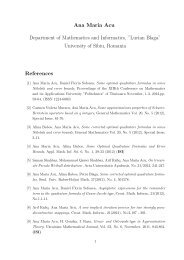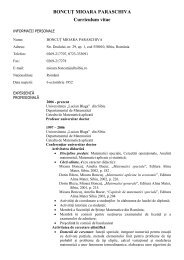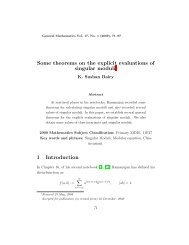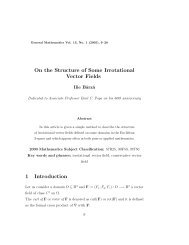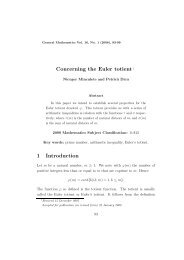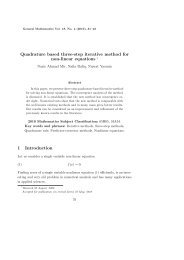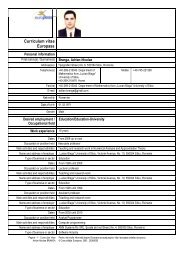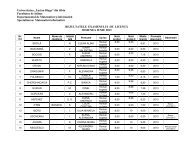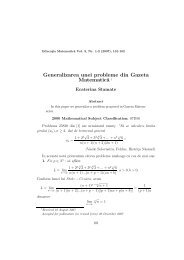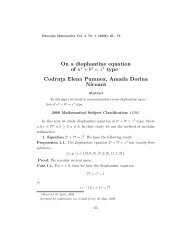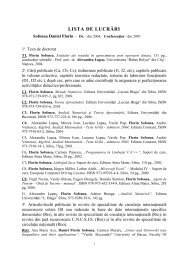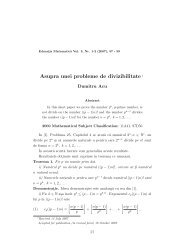Critical thinking - applied to the methodology of teaching mathematics
Critical thinking - applied to the methodology of teaching mathematics
Critical thinking - applied to the methodology of teaching mathematics
Create successful ePaper yourself
Turn your PDF publications into a flip-book with our unique Google optimized e-Paper software.
Educaţia Matematică Vol. 1, Nr. 1 (2005), 57–66<br />
<strong>Critical</strong> <strong>thinking</strong> - <strong>applied</strong> <strong>to</strong> <strong>the</strong><br />
<strong>methodology</strong> <strong>of</strong> <strong>teaching</strong> ma<strong>the</strong>matics<br />
Ioana Mărcuţ<br />
Abstract<br />
<strong>Critical</strong> <strong>thinking</strong> can be seen as having two components:<br />
1. a set <strong>of</strong> skills <strong>to</strong> process and generate information and beliefs;<br />
2. <strong>the</strong> habit, based on intellectual commitment, <strong>of</strong> using those<br />
skills <strong>to</strong> guide behavior.<br />
It is thus <strong>to</strong> be contrasted with:<br />
1. <strong>the</strong> mere acquisition and retention <strong>of</strong> information alone, (because<br />
it involves a particular way in which information is sought<br />
and treated);<br />
2. <strong>the</strong> mere possession <strong>of</strong> a set <strong>of</strong> skills, (because it involves <strong>the</strong><br />
continual use <strong>of</strong> <strong>the</strong>m);<br />
3. <strong>the</strong> mere use <strong>of</strong> those skills (”as an exercise”) without acceptance<br />
<strong>of</strong> <strong>the</strong>ir results.<br />
2000 Ma<strong>the</strong>matical Subject Classification: 97D50<br />
57
58 Ioana Mărcuţ<br />
1 A short his<strong>to</strong>ry <strong>of</strong> critical <strong>thinking</strong><br />
The intellectual roots <strong>of</strong> critical <strong>thinking</strong> are as ancient as its etymology,<br />
traceable, ultimately, <strong>to</strong> <strong>the</strong> <strong>teaching</strong> practice and vision <strong>of</strong> Socrates 2500<br />
years ago. His method <strong>of</strong> questioning is now known as <strong>the</strong> “Socratic questioning”<br />
and is <strong>the</strong> best known critical <strong>thinking</strong> <strong>teaching</strong> strategy.<br />
Socrates practice was followed by <strong>the</strong> critical <strong>thinking</strong> <strong>of</strong> Pla<strong>to</strong>, Aris<strong>to</strong>tel<br />
and <strong>the</strong> Greek skeptics, all <strong>of</strong> whom emphasized that things are <strong>of</strong>ten very<br />
different from what <strong>the</strong>y appear <strong>to</strong> be and only <strong>the</strong> trained mind is prepared<br />
<strong>to</strong> see through <strong>the</strong> way things look <strong>to</strong> us on <strong>the</strong> surface <strong>to</strong> <strong>the</strong> way <strong>the</strong>y really<br />
are beneath <strong>the</strong> surface.<br />
In <strong>the</strong> middle ages, <strong>the</strong> tradition <strong>of</strong> systematic critical <strong>thinking</strong> was<br />
embodied in <strong>the</strong> writings and <strong>teaching</strong>s <strong>of</strong> thinkers such as Thomas Aquinas.<br />
During <strong>the</strong> Renaissance, a flood <strong>of</strong> scholars in Europe began <strong>to</strong> think critically<br />
about religion, art, society, human nature, law and freedom. Among<br />
<strong>the</strong>se scholars were Colet, Erasmus, More, Bacon.<br />
Fifty years later in France, Descartes wrote <strong>the</strong> Rules for <strong>the</strong> Direction <strong>of</strong><br />
<strong>the</strong> Mind, where he argued for <strong>the</strong> need for a special systematic disciplining<br />
<strong>of</strong> <strong>the</strong> mind <strong>to</strong> guide in <strong>thinking</strong>, so that every part <strong>of</strong> <strong>thinking</strong> should be<br />
questioned, doubted and tested.<br />
The critical <strong>thinking</strong> <strong>of</strong> <strong>the</strong> Rennaissance and post Rennaissace scholars<br />
opened <strong>the</strong> way for <strong>the</strong> emergence <strong>of</strong> science and for <strong>the</strong> development <strong>of</strong><br />
democracy, human rights and freedom <strong>of</strong> thought.<br />
It was in <strong>the</strong> spirit <strong>of</strong> intellectual freedom and critical thought that<br />
people such as Robert Boyle and Isaac New<strong>to</strong>n did <strong>the</strong>ir work. In his Sceptical<br />
Chymist, Boyle severely criticized <strong>the</strong> chemical <strong>the</strong>ory that preceded<br />
him. New<strong>to</strong>n, in turn, developed a far-reaching framework <strong>of</strong> thought which
<strong>Critical</strong> <strong>thinking</strong> - <strong>applied</strong> <strong>to</strong> <strong>the</strong> <strong>methodology</strong> <strong>of</strong> <strong>teaching</strong> ma<strong>the</strong>matics 59<br />
roundly criticized <strong>the</strong> traditionally accepted world view.<br />
Ano<strong>the</strong>r significant contribution <strong>to</strong> critical <strong>thinking</strong> was made by <strong>the</strong><br />
thinkers <strong>of</strong> <strong>the</strong> French Enlightenment: Bayle, Montesquieu, Voltaire and<br />
Diderot. They all began with <strong>the</strong> premise that <strong>the</strong> human mind, when<br />
disciplined by reason, is better able <strong>to</strong> figure out <strong>the</strong> nature <strong>of</strong> <strong>the</strong> social<br />
and political world.<br />
In <strong>the</strong> 19th Century, critical thought was extended even fur<strong>the</strong>r in<strong>to</strong> <strong>the</strong><br />
domain <strong>of</strong> human social life by Comte and Spencer.<br />
In <strong>the</strong> 20th Century, our understanding <strong>of</strong> <strong>the</strong> power and nature <strong>of</strong><br />
critical <strong>thinking</strong> has emerged in increasingly more explicit formulations.<br />
To sum up, <strong>the</strong> <strong>to</strong>ols and resources <strong>of</strong> <strong>the</strong> critical thinker have been vastly<br />
increased in virtue <strong>of</strong> <strong>the</strong> his<strong>to</strong>ry <strong>of</strong> critical thought. Hundreds <strong>of</strong> thinkers<br />
have contributed <strong>to</strong> its development. Each major discipline has made some<br />
contribution <strong>to</strong> critical thought. Yet most educational purposes, it is <strong>the</strong><br />
summing up <strong>of</strong> base-line common denomina<strong>to</strong>rs for critical <strong>thinking</strong> that is<br />
most important. Let us consider now that summation.<br />
The result <strong>of</strong> <strong>the</strong> collective contribution <strong>of</strong> <strong>the</strong> his<strong>to</strong>ry <strong>of</strong> critical thought<br />
is that <strong>the</strong> basic questions <strong>of</strong> Socrates can now be much more powerfully and<br />
focally framed and used. In every domain <strong>of</strong> human thought, and within<br />
every use <strong>of</strong> reasoning within any domain, it is now possible <strong>to</strong> question:<br />
• ends and objectives,<br />
• <strong>the</strong> status and wording <strong>of</strong> questions,<br />
• <strong>the</strong> sources <strong>of</strong> information and fact,<br />
• <strong>the</strong> method and quality <strong>of</strong> information collection,
60 Ioana Mărcuţ<br />
• <strong>the</strong> mode <strong>of</strong> judgement and reasoning used,<br />
• <strong>the</strong> concepts that make that reasoning possible,<br />
• <strong>the</strong> assumptions that underlie concepts in use,<br />
• <strong>the</strong> implications that follow from <strong>the</strong>ir use, and<br />
• <strong>the</strong> point <strong>of</strong> view <strong>of</strong> <strong>the</strong> frame <strong>of</strong> reference within which reasoning<br />
takes place.<br />
In o<strong>the</strong>r words, questioning that focuses on <strong>the</strong>se fundamentals <strong>of</strong> thought<br />
and reasoning are now baseline in critical <strong>thinking</strong>. It is beyond question<br />
that intellectual errors or mistakes can occur in any <strong>of</strong> <strong>the</strong>se dimensions,<br />
and that students need <strong>to</strong> be fluent in talking about <strong>the</strong>se structures and<br />
standards.<br />
2 <strong>Critical</strong> <strong>thinking</strong> and <strong>the</strong> <strong>methodology</strong> <strong>of</strong><br />
<strong>teaching</strong> ma<strong>the</strong>matics<br />
2.1 <strong>Critical</strong> <strong>thinking</strong> and problem solving<br />
Promoting critical <strong>thinking</strong> and problem solving in ma<strong>the</strong>matics education<br />
is crucial in <strong>the</strong> development <strong>of</strong> successful students. <strong>Critical</strong> <strong>thinking</strong> and<br />
problem solving go hand in hand. In order <strong>to</strong> learn ma<strong>the</strong>matics through<br />
problem solving, <strong>the</strong> students must also learn how <strong>to</strong> think critically.<br />
There are five values <strong>of</strong> <strong>teaching</strong> through problem solving:<br />
• problem solving focuses <strong>the</strong> student , s attention on ideas and sense<br />
making ra<strong>the</strong>r than memorization <strong>of</strong> facts;
<strong>Critical</strong> <strong>thinking</strong> - <strong>applied</strong> <strong>to</strong> <strong>the</strong> <strong>methodology</strong> <strong>of</strong> <strong>teaching</strong> ma<strong>the</strong>matics 61<br />
• problem solving develops <strong>the</strong> student ′ s belief that <strong>the</strong>y are capable <strong>of</strong><br />
doing ma<strong>the</strong>matics and that ma<strong>the</strong>matics makes sense;<br />
• it provides ongoing assessment data that can be used <strong>to</strong> make instructional<br />
decisions, help students succeed, and inform parents;<br />
• <strong>teaching</strong> through problem solving is fun and when learning is fun,<br />
students have a better chance <strong>of</strong> remembering it later.<br />
Some principles <strong>of</strong> problem solving:<br />
The primary objective is <strong>to</strong> help <strong>the</strong> student <strong>to</strong> become aware <strong>of</strong> <strong>the</strong><br />
fact that problem solving is not a special area but instead uses <strong>the</strong> same<br />
logical processes <strong>to</strong> which <strong>the</strong>y are already familiar and use routinely. The<br />
problem statement itself is <strong>the</strong> primary cause <strong>of</strong> novice students difficulty in<br />
solving word problems. The solution is <strong>to</strong> ignore, when reading a problem<br />
statement, any phrases that start with words like “if”. The initial action<br />
in starting a solution is identifying what is asked for. The student must<br />
be learned <strong>to</strong> verbalize. A verbal statement following <strong>the</strong> final result is <strong>of</strong><br />
particular importance: what does <strong>the</strong> result tell me In addition <strong>to</strong> completing<br />
<strong>the</strong> solution, <strong>the</strong> ending statement serves as a quick check <strong>of</strong> one , s<br />
work. An adequate solution presentation does not have <strong>to</strong> be explained.<br />
2.2 <strong>Critical</strong> <strong>thinking</strong> in <strong>the</strong> maths lesson<br />
Ma<strong>the</strong>matics is <strong>of</strong>ten held up as <strong>the</strong> model <strong>of</strong> a discipline based on rational<br />
thought, clear, concise language and attention <strong>to</strong> <strong>the</strong> assumption and<br />
decision-making techniques that are used <strong>to</strong> draw conclusions.<br />
In 1938, Harold Fawcett introduced <strong>the</strong> idea that students could learn<br />
ma<strong>the</strong>matics through experiences <strong>of</strong> critical <strong>thinking</strong>. His goals included
62 Ioana Mărcuţ<br />
<strong>the</strong> following ways that students could demonstrate that <strong>the</strong>y were, in fact,<br />
<strong>thinking</strong> critically, as <strong>the</strong>y participated in <strong>the</strong> experiences <strong>of</strong> <strong>the</strong> classroom:<br />
1. Selecting <strong>the</strong> significant words and phrases in any statement that is<br />
important, and asking that <strong>the</strong>y be carefully defined.<br />
2. Requiring evidence <strong>to</strong> support conclusions <strong>the</strong>y are pressed <strong>to</strong> accept.<br />
3. Analyzing that evidence and distinguishing fact from assumption.<br />
4. Recognizing stated and unstated assumptions essential <strong>to</strong> <strong>the</strong> conclusion.<br />
5. Evaluating <strong>the</strong>se assumptions, accepting some and rejecting o<strong>the</strong>rs.<br />
6. Evaluating <strong>the</strong> argument, accepting or rejecting <strong>the</strong> conclusion.<br />
7. Constantly reexamining <strong>the</strong> assumptions that are behind <strong>the</strong>ir beliefs<br />
and actions.<br />
Fifty years later, <strong>the</strong> critical <strong>thinking</strong> is still present in <strong>the</strong> goals, but it<br />
has been subsumed by more holistic notions <strong>of</strong> what it means <strong>to</strong> teach, do<br />
and understand ma<strong>the</strong>matics. The students will be able <strong>to</strong>:<br />
1. Organize and consolidate <strong>the</strong>ir ma<strong>the</strong>matical <strong>thinking</strong> through communication;<br />
2. Communicate <strong>the</strong>ir ma<strong>the</strong>matical <strong>thinking</strong> coherently and clearly <strong>to</strong><br />
peers, teachers, and o<strong>the</strong>rs;<br />
3. Analyze and evaluate <strong>the</strong> ma<strong>the</strong>matical <strong>thinking</strong> and strategies <strong>of</strong><br />
o<strong>the</strong>rs;
<strong>Critical</strong> <strong>thinking</strong> - <strong>applied</strong> <strong>to</strong> <strong>the</strong> <strong>methodology</strong> <strong>of</strong> <strong>teaching</strong> ma<strong>the</strong>matics 63<br />
4. Use <strong>the</strong> language <strong>of</strong> ma<strong>the</strong>matics <strong>to</strong> express ma<strong>the</strong>matical ideas precisely.<br />
These ideas are very similar <strong>to</strong> those promoted by Fawcett in 1938.<br />
Little has changed in <strong>the</strong> mainstream ways that people tend <strong>to</strong> define critical<br />
<strong>thinking</strong> in <strong>the</strong> context <strong>of</strong> ma<strong>the</strong>matics education. Students are expected <strong>to</strong><br />
search for <strong>the</strong> strengths and weaknesses <strong>of</strong> each and every strategy <strong>of</strong>fered.<br />
It is no longer good enough <strong>to</strong> reach an answer <strong>to</strong> a problem that was posed.<br />
Now, students are cajoled in<strong>to</strong> communicating <strong>the</strong>ir own ideas well, and <strong>to</strong><br />
demand <strong>the</strong> same communication from o<strong>the</strong>rs. A shift has occured from<br />
listing skills <strong>to</strong> be learned <strong>to</strong>ward attributes <strong>of</strong> classrooms that promote<br />
critical <strong>thinking</strong> as part <strong>of</strong> <strong>the</strong> experience <strong>of</strong> that classroom.<br />
Such a class <strong>to</strong> promote critical <strong>thinking</strong> can be created by providing<br />
<strong>the</strong> conditions for <strong>the</strong> students <strong>to</strong> communicate with one ano<strong>the</strong>r in order<br />
<strong>to</strong> reflect <strong>to</strong>ge<strong>the</strong>r on <strong>the</strong> solution <strong>to</strong> <strong>the</strong> problem. The first condition is<br />
for <strong>the</strong> students <strong>to</strong> feel free in expressing <strong>the</strong>ir ideas. Then, <strong>the</strong>y must be<br />
able <strong>to</strong> listen attentively <strong>to</strong> <strong>the</strong>ir classmates and show interest in <strong>the</strong>ir ideas.<br />
So, <strong>the</strong>y communicate both for learning ma<strong>the</strong>matics and in ma<strong>the</strong>matical<br />
terms. On <strong>the</strong> o<strong>the</strong>r hand, <strong>the</strong> students get accus<strong>to</strong>med <strong>to</strong> group work<br />
which implies mutual help and cooperation for a mutual aim.<br />
2.3 The experiment achieved in class<br />
The experiment was developed throughout a whole school year. The two<br />
groups (<strong>the</strong> one <strong>to</strong> which <strong>the</strong> experiment was <strong>applied</strong> and <strong>the</strong> one for checkup)<br />
were two graduating class having <strong>the</strong> same vocational pr<strong>of</strong>ile, homogeneous<br />
enough as far as <strong>the</strong>ir level <strong>of</strong> ma<strong>the</strong>matical training is concerned.
64 Ioana Mărcuţ<br />
With one class I worked in <strong>the</strong> traditional way, using mostly <strong>the</strong> direct<br />
method. With <strong>the</strong> experimental class, group work was most <strong>of</strong>ten used.<br />
The groups were made up <strong>of</strong> 4 students. Each group was given a handout<br />
with problems <strong>to</strong> solve <strong>to</strong>ge<strong>the</strong>r. While working on it, <strong>the</strong> members <strong>of</strong> each<br />
group talked <strong>to</strong>ge<strong>the</strong>r, helped one ano<strong>the</strong>r and appealed <strong>to</strong> <strong>the</strong> teacher when<br />
<strong>the</strong>y needed help. Their endeavors and interest in understanding both <strong>the</strong><br />
data and <strong>the</strong> requirements <strong>of</strong> <strong>the</strong> problem could be noticed, and <strong>the</strong>y were<br />
all preoccupied by <strong>the</strong> understanding <strong>of</strong> <strong>the</strong> solution. The students worked<br />
<strong>to</strong>ge<strong>the</strong>r for <strong>the</strong> whole class. The ones with better knowledge <strong>of</strong> maths were<br />
helping <strong>the</strong> o<strong>the</strong>rs. In <strong>the</strong> case <strong>of</strong> <strong>the</strong> good students, explaining <strong>the</strong> solution<br />
<strong>to</strong> <strong>the</strong>ir classmates engenders a deeper understanding; on <strong>the</strong> o<strong>the</strong>r hand,<br />
<strong>the</strong> o<strong>the</strong>r students seem <strong>to</strong> reach <strong>the</strong> understanding <strong>of</strong> <strong>the</strong> solution easier<br />
when <strong>the</strong> explanation comes from a pair than when it is <strong>the</strong> teacher who is<br />
giving it.<br />
With <strong>the</strong> o<strong>the</strong>r group, where one student was required <strong>to</strong> solve <strong>the</strong> problem<br />
on <strong>the</strong> black-board, a lack <strong>of</strong> interest was noticed: <strong>the</strong> rest <strong>of</strong> <strong>the</strong><br />
students were merely copying <strong>the</strong> solution, without trying <strong>to</strong> think <strong>of</strong> <strong>the</strong><br />
problem <strong>the</strong>mselves.<br />
On <strong>the</strong> average, <strong>the</strong> same number <strong>of</strong> problems were solved during one<br />
class with each <strong>of</strong> <strong>the</strong> two groups, but those were encouraged <strong>to</strong> express <strong>the</strong>ir<br />
ideas freely, <strong>to</strong> think, <strong>to</strong> formulate hypo<strong>the</strong>ses, <strong>to</strong> listen <strong>to</strong> one ano<strong>the</strong>r and<br />
mutually estimate <strong>the</strong>ir judgements, had better results in <strong>the</strong> graduation<br />
exam. Besides, <strong>the</strong> math classes were very enjoyable and attractive for <strong>the</strong><br />
students <strong>of</strong> this group.
<strong>Critical</strong> <strong>thinking</strong> - <strong>applied</strong> <strong>to</strong> <strong>the</strong> <strong>methodology</strong> <strong>of</strong> <strong>teaching</strong> ma<strong>the</strong>matics 65<br />
3 Conclusions<br />
It is undoubtedly easier for <strong>the</strong> teacher <strong>to</strong> teach <strong>the</strong> maths lesson <strong>the</strong> traditional<br />
way, <strong>the</strong> way has been doing it for years - with <strong>the</strong> black-board, <strong>the</strong><br />
chalk, endless explanations and repetition <strong>of</strong> <strong>the</strong> same algorithms.<br />
This paper is a challenge for <strong>the</strong> colleagues, an urge for <strong>the</strong>m <strong>to</strong> try<br />
something else. Of course it is not easy and nei<strong>the</strong>r does it happen <strong>to</strong> us<br />
<strong>to</strong> have <strong>the</strong> students develop critical <strong>thinking</strong> from <strong>the</strong> first attempt. The<br />
process takes time and experience from both <strong>the</strong> teacher , s and <strong>the</strong> students<br />
part. It is also required a very thorough preparation <strong>of</strong> <strong>the</strong> lesson, specially<br />
designed materials and mobile classroom furniture. The more homogeneous<br />
<strong>the</strong> groups are, <strong>the</strong> sooner <strong>the</strong>y will be successful.<br />
I personally consider <strong>the</strong>se lessons particularly efficient, both from <strong>the</strong><br />
point <strong>of</strong> view <strong>of</strong> <strong>the</strong> learning <strong>of</strong> maths, as well as considering <strong>the</strong> development<br />
<strong>of</strong> <strong>the</strong>ir skills in analyzing, reasoning, decision-making, communicating and,<br />
last but not least, listening <strong>to</strong> o<strong>the</strong>rs and cooperating for <strong>the</strong> achievement<br />
<strong>of</strong> a mutual goal.<br />
References<br />
[1] S. I. Brown, Reconstructing school ma<strong>the</strong>matics: Problems with problems<br />
and real world NY, Peter Lang, 2001;<br />
[2] E. Glazer, Using internet primary sources <strong>to</strong> teach critical <strong>thinking</strong><br />
skills in ma<strong>the</strong>matics, Westport, CT: Greenwood Publishing Group,<br />
2001;
66 Ioana Mărcuţ<br />
[3] D. Weil, (ed.) International Encyclopedia <strong>of</strong> <strong>Critical</strong> Thinking, ABC-<br />
CLIO, 2003.<br />
Colegiul Naţional Pedagogic “Andrei Şaguna” Sibiu<br />
E-mail address: igmarcut@yahoo.com


